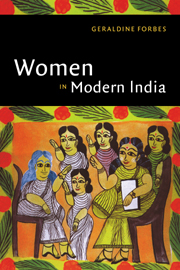Book contents
- Frontmatter
- Introduction
- 1 Reform in the nineteenth century: efforts to modernize women's roles
- 2 Education for women
- 3 The emergence of women's organizations
- 4 The movement for women's rights
- 5 Women in the nationalist movement
- 6 Women's work in colonial India
- 7 A time of transition
- 8 Women in independent India
- Bibliographic essay
- Index
- THE NEW CAMBRIDGE HISTORY OF INDIA
- References
3 - The emergence of women's organizations
Published online by Cambridge University Press: 28 March 2008
- Frontmatter
- Introduction
- 1 Reform in the nineteenth century: efforts to modernize women's roles
- 2 Education for women
- 3 The emergence of women's organizations
- 4 The movement for women's rights
- 5 Women in the nationalist movement
- 6 Women's work in colonial India
- 7 A time of transition
- 8 Women in independent India
- Bibliographic essay
- Index
- THE NEW CAMBRIDGE HISTORY OF INDIA
- References
Summary
The educational experiments of the late nineteenth and early twentieth centuries produced a ‘new woman’ with interests that went beyond the household. Lado Rani Zutshi, the mother of Manmohini Sahgal, was educated at home by tutors. Manmohini wrote about her mother:
[she] settled in Lahore in 1917 to educate her daughters … she joined the YWCA to continue her English and painting lessons. In the evenings she went to her class riding a bicycle. No other Indian lady of her status in Lahore had the courage to do this … In Lahore, she started a ladies’ recreation club and became its president.
For the first time in India's history women began to communicate with women outside their families and local communities. On the one hand there was a small group of women who shared English as a common language. This made possible communication across language barriers. On the other hand, there were growing numbers of women literate in the vernaculars which enabled them to learn about women's issues in the new women' s journals. Both groups, marginalized by more traditional society, sought the companionship of women like themselves. Encouraged by their male guardians to ‘move with the times’ they joined the new clubs and associations formed for women. From small local clubs and women's auxiliaries of the Indian National Congress and the National Social Conference came a variety of organizations and associations that reflected women's concerns. By the eve of Independence in 1947 a coalition of national women's organizations could rightfully claim it was the second most representative body in India.
- Type
- Chapter
- Information
- Women in Modern India , pp. 64 - 91Publisher: Cambridge University PressPrint publication year: 1996
References
- 1
- Cited by



